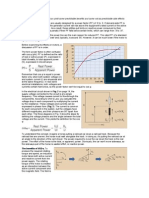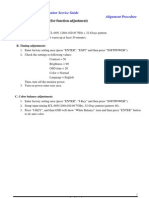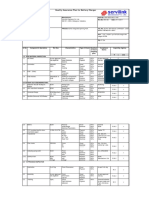Taming The Variable Speed Motor
Uploaded by
BalasundaramSrinivasaRajkumarTaming The Variable Speed Motor
Uploaded by
BalasundaramSrinivasaRajkumarTaming the variable speed motor
Understanding harmonics and motor problems can improve system reliability Application Note
The pulse-width modulated (PWM) motor drive has become the ac variable speed drive method of choice, especially for low- to medium-horsepower applications. The technology has distinct advantages over other configurations in that it is typically less costly, more efficient, and produces fewer harmonic problems for the input power lines. It also can be tricky to troubleshoot. To gain a better understanding of the problems typically encountered with PWM drives, first lets examine the basic building blocks of a variable speed drive. Its circuit is straightforward: the input circuit contains a full-wave diode bridge that rectifies the line voltage and charges a capacitor bank to a dc voltage equal to halfwave peak of the line voltage. The drives output stage contains some fast switching power transistors that chop the dc into a series of narrow voltage pulses that are applied to the motor leads. The height of the pulses are the same as the dc value on the capacitor bank, but the width of the pulses are modulated (or varied) in such a way that motor current approximates a sine wave. The drive circuit can be very efficient, because neither the input diodes nor the output transistors generate much heat. In general, problems with variable speed motor drives can be separated into two parts: 1. Power line harmonics generated by the drives input circuit 2. Motor difficulties caused by the output circuit
If we are going to tame the variable speed drive circuit, we need to divide it into two parts: input and output. The requirements for test equipment will vary according to which end of the drive we are measuring. At the input, we will want to measure true-rms current, plus harmonic current spectrum and power factor using a harmonic analyzer like the Fluke 43B Power Quality Analyzer. At the output, we need the same harmonic analyzer to look at the motor current and a fast oscilloscope such as the ScopeMeter 199C to look at the motor voltage. Both instruments feature high EMI shielding which is needed when taking measurements near the fast pulses on the drives output leads.
Reducing harmonics at the drives input
If the drive is connected to a three-phase source, the current waveform in any one phase will have a double hump shape similar to that shown in Figure 1. This waveform typically contains fifth and seventh harmonics as shown in the accompanying spectrum. Harmonic filters can be used to reduce these harmonics.
Fluke 43B measuring PWM motor drive voltage and current
Three-Phase Rectifier Current Waveform
Harmonic Spectrum
Figure 1. Line current waveform and associated harmonic spectrum for a three-phase PWM drive.
Line
Load
Troubleshooting motor problems
Winding insulation failures are the greatest concern for obvious reasons. Damaged insulation means replacement or rewinding, which can translate to a logistics problem if you dont have a spare handy. Winding insulation can fail from too much heat, too much voltage, or both. Unfortunately, a misapplied variable speed drive can deliver both simultaneously. Overvoltage can occur when the distance between the drive and the motor exceeds the drive manufacturers maximum cable length specification. The theory here does not involve the National Electrical Code. Instead, it comes from the laws of radio frequency transmission lines. Remember whats happening at the drives output terminals. Very fast rise time pulses are being sent down a set of conductors that have distributed inductance and capacitance. That is, the cable resembles a transmission line. Each pulse travels down the cable at near the speed of light. When the leading edge hits the motor inductance, it is reflected back to the source, where it adds to the base value of the pulse. The resulting combination puts a sharp spike on the leading edge of each pulse. The spikes can be as high as twice the base pulse value. Longer cables make the problem worse. In order to see this effect, you will need an oscilloscope or a handheld portable ScopeMeter test tool with a bandwidth of at least 10 MHz and the ability to trigger on a PWM waveform. (See Figure 3). If you plan to install a variable speed drive where the distance to the motor exceeds the drive manufacturers maximum cable length specification, be sure to ask for recommendations involving output filters or other methods of reducing the overvoltage spike problem.
Figure 3. Voltage waveform on a PWM drive output with a long cable between drive and motor.
Figure 2. Trap filter for a three-phase PWM drive.
When the application is a single large drive, a trap filter can be installed at the drive input. A typical configuration of a commercially available trap filter is shown in Figure 2. The value of the capacitors is determined by the horsepower rating of the drive, and the inductors are chosen to make the circuit resonant slightly below the fifth harmonic. These values will greatly reduce the amount of the fifth and seventh harmonics reaching the service. In addition, the capacitors will provide some power factor correction at the 60 Hz line frequency. If you ask for a price quote on a filter, the filter designer will probably ask for a one-line diagram of your power system, horsepower rating of the drive and measured harmonic spectrum, plus power factor of the drives full load current. The latter two items are easily captured by a handheld harmonic analyzer.
The second category of insulation failure is overheating. Rising temperatures are caused by too much copper loss, not enough cooling, or a combination of the two. Problems with overheated motors can often be traced to a mismatch between the motors torque capability and the loads requirements. Remember that torque is generated by current, and copper losses are proportional to current squared. If the load is a conveyor belt that requires high torque at low rpm, and where cooling is minimal, overheating is likely if the motor is not sized properly. On the other hand, if the load is a pump or a fan that obeys the laws of fluid mechanics, the torque requirements will go down with the speed. When a drive is being matched to a particular motor and load combination, an important measured parameter is the volt-hertz product of the drive output. Motor theory says that as the rpm is reduced, the voltage also must be reduced. Measuring the volt-hertz product can be tricky unless you use test tools with EMI shielding adequate to work around the fast rise time pulses on the variable speed output terminals. The problem is further complicated by the fact
2 Fluke Corporation
Taming the variable speed motor
that a true-rms digital multimeter (DMM) will read high on the voltage output because the DMM will respond to the high frequency components the motor itself does not see. If you need to measure the volt-hertz product of a variable speed drive, here are some recommendations that will help you get good readings: Find the hertz by measuring the frequency of the motor current. The current waveform is actually close to sinusoidal, so it is much easier to measure than the PWM voltage signal. Use a well-shielded integral clamp meter that has a frequency function, such as the Fluke 337. As an alternate, use a digital multimeter such as the Fluke 189 that can display
frequency in the current function and use an ac current transformer type clamp accessory that connects to the meters current inputs. The CTtype clamp accessory (ac only) is preferable because its mA signal goes into a low impedance input which is less susceptible to noise than the high impedance input used for mV signals. Find the motor voltage by using a harmonic analyzer that will read out the rms value of the fundamental component (only) of the output voltage. This value will be lower than the true-rms voltage, but it will correspond very closely to the voltage that the motor actually sees.
In the end, one thing is certain: the variable speed drive is here to stay. Careful application of these principles and cautions can help you take advantage of its benefits, while making sure it works for, not against, your application
Work safely
The high voltage and currents present in electrical power systems can cause serious injury or death by electrocution and burns. Consequently, only trained, experienced electricians who have knowledge of electrical systems in general and the equipment under test should perform testing and modification of electrical systems. Fluke cannot anticipate all possible precautions that you must take when performing the measurements described here. At a minimum, however, you should: Use appropriate safety equipment such as safety glasses, insulated gloves, insulating mats, etc. Be sure that all power has been turned off, locked out, and tagged in any situation where you will be in direct contact with circuit components. Be certain that the power cant be turned on by anyone but you. Read and understand all of the applicable manuals before applying the information in this application note. Take special note of all safety precautions and warnings in the instruction manuals. Do not use instruments on applications for which they are not intended, and always be aware that if the equipment is used in a manner not specified by the manufacturer, the protection provided by the equipment may be impaired.
Fluke. Keeping your world up and running.
Fluke Corporation PO Box 9090, Everett, WA USA 98206 Fluke Europe B.V. PO Box 1186, 5602 BD Eindhoven, The Netherlands For more information call: In the U.S.A. (800) 443-5853 or Fax (425) 446-5116 In Europe/M-East/Africa (31 40) 2 675 200 or Fax (31 40) 2 675 222 In Canada (800) 36-FLUKE or Fax (905) 890-6866 From other countries +1 (425) 446-5500 or Fax +1 (425) 446-5116 Web access: http://www.fluke.com
2002 Fluke Corporation. All rights reserved. 2/2003 Pub-ID 10604-eng Rev. 01
You might also like
- Variable Frequency Drive (VFD) Interview Questions100% (1)Variable Frequency Drive (VFD) Interview Questions9 pages
- Chapter 3-Diodes Rectifiers: 180 V, R 15, F 60 HZNo ratings yetChapter 3-Diodes Rectifiers: 180 V, R 15, F 60 HZ31 pages
- Schaffner An Filter Solutions For Motor Drives ApplicationsNo ratings yetSchaffner An Filter Solutions For Motor Drives Applications28 pages
- How To Troubleshoot Motors and Drives, Starting at The InputsNo ratings yetHow To Troubleshoot Motors and Drives, Starting at The Inputs5 pages
- How To Troubleshoot Motors and Drives at The Inputs - FlukeNo ratings yetHow To Troubleshoot Motors and Drives at The Inputs - Fluke10 pages
- 3-Phase Motor Drives W Oscilloscope 48W-73863-1No ratings yet3-Phase Motor Drives W Oscilloscope 48W-73863-134 pages
- Analysis and Diagnostic Troubleshooting Reference Guide: Fluke MDA-550 Motor Drive AnalyzerNo ratings yetAnalysis and Diagnostic Troubleshooting Reference Guide: Fluke MDA-550 Motor Drive Analyzer7 pages
- Reference Guide To Useful Electronic Circuits And Circuit Design Techniques - Part 1From EverandReference Guide To Useful Electronic Circuits And Circuit Design Techniques - Part 12.5/5 (3)
- 3-Phase Motor Drives W Oscilloscope 48W-73863-0No ratings yet3-Phase Motor Drives W Oscilloscope 48W-73863-031 pages
- PF I V PF I V PF I V P P: I Computing The Power in A Three Phase MotorNo ratings yetPF I V PF I V PF I V P P: I Computing The Power in A Three Phase Motor4 pages
- The Effects of Load Types On The Behavior of Ac Motor Drives DurNo ratings yetThe Effects of Load Types On The Behavior of Ac Motor Drives Dur6 pages
- Troubleshoot Transient Voltages in Variable Frequency Drives - FlukeNo ratings yetTroubleshoot Transient Voltages in Variable Frequency Drives - Fluke5 pages
- Vincotech TP-2018-11-v001 Power Modules in Low Power Drive applications-FINNo ratings yetVincotech TP-2018-11-v001 Power Modules in Low Power Drive applications-FIN6 pages
- An Improved Approach For Connecting VSD and Electric Motors PDFNo ratings yetAn Improved Approach For Connecting VSD and Electric Motors PDF8 pages
- Reference Guide To Useful Electronic Circuits And Circuit Design Techniques - Part 2From EverandReference Guide To Useful Electronic Circuits And Circuit Design Techniques - Part 2No ratings yet
- Transient Voltage Reflection Analysis in PWM Inverter Fed AC Drives and Experimental VerificationNo ratings yetTransient Voltage Reflection Analysis in PWM Inverter Fed AC Drives and Experimental Verification6 pages
- Improving Power Factor With Variable Speed AC DrivesNo ratings yetImproving Power Factor With Variable Speed AC Drives5 pages
- PWM Motor Drive Fault Detection 0910 PDFNo ratings yetPWM Motor Drive Fault Detection 0910 PDF8 pages
- Aplicacion Variadores de Velocidad Fluke 289No ratings yetAplicacion Variadores de Velocidad Fluke 2895 pages
- Influence of System Parameters Using Fuse Protection of Regenerative DC DrivesFrom EverandInfluence of System Parameters Using Fuse Protection of Regenerative DC DrivesNo ratings yet
- Problems Often Occur Because of The Words We Use To Describe A ProjectNo ratings yetProblems Often Occur Because of The Words We Use To Describe A Project83 pages
- Problems Often Occur Because of The Words We Use To Describe A ProjectNo ratings yetProblems Often Occur Because of The Words We Use To Describe A Project83 pages
- STEM: Science, Technology, Engineering and Maths Principles Teachers Pack V10From EverandSTEM: Science, Technology, Engineering and Maths Principles Teachers Pack V10No ratings yet
- Design Considerations For An Inverter Output Filter To Mitigate The Effects of Long Motor Leads INo ratings yetDesign Considerations For An Inverter Output Filter To Mitigate The Effects of Long Motor Leads I8 pages
- Predictive Maintenance of Induction Motors With MCSA & TSA TechnologyNo ratings yetPredictive Maintenance of Induction Motors With MCSA & TSA Technology131 pages
- MeasurementBestPractices WillwerthHammond 0612No ratings yetMeasurementBestPractices WillwerthHammond 061218 pages
- The Installation of AC Drives Can Yield Some Predictable Benefits and Some Not-So-Predictable Side EffectsNo ratings yetThe Installation of AC Drives Can Yield Some Predictable Benefits and Some Not-So-Predictable Side Effects3 pages
- Cálculo Dos Parâmetros para Diferentes Disposições Do Cabo - Hélder (2011)No ratings yetCálculo Dos Parâmetros para Diferentes Disposições Do Cabo - Hélder (2011)6 pages
- Protecting Submersible Motors From The Effects of PWM VoltageNo ratings yetProtecting Submersible Motors From The Effects of PWM Voltage6 pages
- Electric Vehicle Using Three Phase Induction Motor: Amrita Vishwa Vidyapeetham EEE DepartmentNo ratings yetElectric Vehicle Using Three Phase Induction Motor: Amrita Vishwa Vidyapeetham EEE Department28 pages
- Thomson Electrac HD Linear Actuator Motion Control per CAN BusFrom EverandThomson Electrac HD Linear Actuator Motion Control per CAN BusNo ratings yet
- A Review of Mitigation Methods For Overvoltage in Long-Cable-Fed PWM AC DrivesNo ratings yetA Review of Mitigation Methods For Overvoltage in Long-Cable-Fed PWM AC Drives7 pages
- AC Drive Cable Selection PDF From I&S 1263400720No ratings yetAC Drive Cable Selection PDF From I&S 12634007208 pages
- Uso de Reactores para Distancias Largas en CablesNo ratings yetUso de Reactores para Distancias Largas en Cables4 pages
- A Whale in The Heart of Budapest: Installed PumpsNo ratings yetA Whale in The Heart of Budapest: Installed Pumps1 page
- Energy Audits, Improvements in Small Office Buildings: by Ian M. Shapiro, P.E., Member ASHRAENo ratings yetEnergy Audits, Improvements in Small Office Buildings: by Ian M. Shapiro, P.E., Member ASHRAE12 pages
- Hourly Load Profile of District Cooling System With Thermal Energy StorageNo ratings yetHourly Load Profile of District Cooling System With Thermal Energy Storage3 pages
- Grey Cast Iron GG25 - EN GJL 150 - Properties100% (1)Grey Cast Iron GG25 - EN GJL 150 - Properties2 pages
- Structure of Fast Power Diodes 49-53 - SemikronNo ratings yetStructure of Fast Power Diodes 49-53 - Semikron7 pages
- HTTP Freecircuitdiagram - Com 2009-05-09 Dynamic-compressor-self-powered-circuit-DesignNo ratings yetHTTP Freecircuitdiagram - Com 2009-05-09 Dynamic-compressor-self-powered-circuit-Design4 pages
- Quality Assurance Plan For Battery ChargerNo ratings yetQuality Assurance Plan For Battery Charger3 pages
- A Power Decoupling Method Based On Four-Switch Three-Port Dc/Dc/Ac Converter in DC MicrogridNo ratings yetA Power Decoupling Method Based On Four-Switch Three-Port Dc/Dc/Ac Converter in DC Microgrid9 pages
- Parformance - Based Comparision of UPQC Compensating Signal Generation Algorithms Under Disstorted Supply and Non Linear Load ConditionsNo ratings yetParformance - Based Comparision of UPQC Compensating Signal Generation Algorithms Under Disstorted Supply and Non Linear Load Conditions5 pages
- CT-1 Electronics Engineering (CSE) EE KOE 048No ratings yetCT-1 Electronics Engineering (CSE) EE KOE 0482 pages
- Four Quadrant Speed Control of DC Motor Using ChopperNo ratings yetFour Quadrant Speed Control of DC Motor Using Chopper5 pages
- Control Strategy of An Interleaved Boost Power Factor CorrectionNo ratings yetControl Strategy of An Interleaved Boost Power Factor Correction6 pages









































































































